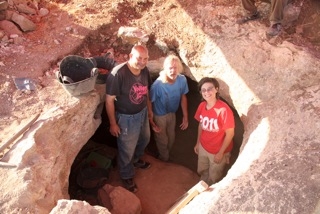
 WELCOME TO THE ASOR BLOG
WELCOME TO THE ASOR BLOG
The American Schools of Oriental Research (ASOR) is the preeminent society for individuals interested in the archaeology of the eastern Mediterranean and the Biblical Lands. This blog is intended to facilitate ASOR’s mission “to initiate, encourage and support research into, and public understanding of, the cultures and history of the Near East from the earliest times.”
A Wonderful Season
By: Amanda Hopkins, 2012 Heritage Fellow

I received financial assistance as a Heritage Fellowship recipient which helped me to purchase my plane ticket. In addition to this practical benefit, I was able to share my experiences through the ASOR blog. Now, as I reflect upon my earlier posts (First, Second, Third, and Last) I have various markers that show me how understanding is a journey of perspective. For example, when we were originally given permission to excavate the cave we imagined that it could be a wine cellar. Now we realize that the depth and shape of the cave best lends itself to being a reservoir or cistern. Digging Tall al-Umayri Survey Site 84 also created several opportunities to better appreciate the daily life of people living in hinterland settlements during the late Iron Age.
These early dwellers’ tenacity and resilience were most keenly felt when we discovered plaster and chiseling on the walls and roof of the cave. This discovery was perhaps the most exhilarating moment of the dig. Especially, since we are following (perhaps) these markers of human ingenuity to the bottom of the cave. I want to see how these people reshaped this natural feature of the landscape so that it would conform to their desire to store water for the production of wine and or olive oil.
“Best practices of cistern production” come from the community’s long-term experience of living in the hinterland. The mixtures of various types of limestone that surround Site 84 include permeable types like the kind we have in our cave. If the marks of the chiseling and the layering of the plaster are any indication then it took an incredible amount of handiwork to prepare the cave’s surfaces and to create an impermeable lining.
Our 2012 dig season also contained moments of levity. Archeologists derive benefit mostly by digging with small picks and trowels. However, for removing years of top fill from windblown dirt, vegetation (of the thistle variety) and human remnants (aluminum soda cans), nothing is better than a good shovel and a pick. However, matching the right wooden handle with the right shovel or pick head can be quite tasking. The shovel and pick heads that are offered for sale in a store may or may not fit the handles that are similarly offered for sale by that same hardware store!!!
We found a similar situation as we covered the cave to protect it and interested bystanders from injury. Ordering the corrugated steel (in Arabic/English), building the wooden fixtures to hold the metal in place- and transporting all these materials…you make friends quickly with locals whose help is much appreciated!
I had a very meaningful experience excavating Hinterland Site 84. I am deeply grateful for the opportunity to be a 2012 recipient of the Heritage Fellowship Award and to be a member of the Tall al- Umayri dig.
~~~
As you know, ASOR’s mission is to support archaeology in the Near East, and now we have an exciting opportunity for you to support students of archaeology directly! Every year ASOR gives out around 30 Platt and Heritage Fellowships to deserving students to defray the costs of excavating in the Near East. Thanks to last year’s March Fellowship Madness drive we gave out a total of 42 scholarships and we are trying to beat that number this year.
Our goal is to raise $10,000, and if we succeed, two generous donors will give funding for four additional fellowships, meaning a total of 14 additional students will get funding this year! Help us seize this opportunity to send more students into the field! Donate now!
All content provided on this blog is for informational purposes only. The American Schools of Oriental Research (ASOR) makes no representations as to the accuracy or completeness of any information on this blog or found by following any link on this blog. ASOR will not be liable for any errors or omissions in this information. ASOR will not be liable for any losses, injuries, or damages from the display or use of this information. The opinions expressed by Bloggers and those providing comments are theirs alone, and do not reflect the opinions of ASOR or any employee thereof.
 WELCOME TO THE ASOR BLOG
WELCOME TO THE ASOR BLOG